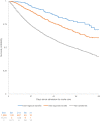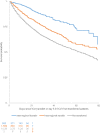Impact of ICU transfers on the mortality rate of patients with COVID-19: insights from comprehensive national database in France
- PMID: 34698966
- PMCID: PMC8546754
- DOI: 10.1186/s13613-021-00933-2
Impact of ICU transfers on the mortality rate of patients with COVID-19: insights from comprehensive national database in France
Abstract
Background: The first wave of the COVID-19 pandemic confronted healthcare systems around the world with unprecedented organizational challenges, particularly regarding the availability of intensive care unit (ICU) beds. One strategy implemented in France to alleviate healthcare pressure during the first COVID-19 wave was inter-hospital transfers of selected ICU patients from overwhelmed areas towards less saturated ones. At the time, the impact of this transfer strategy on patient mortality was unknown. We aimed to compare in-hospital mortality rates among ICU patients with COVID-19 who were transferred to another healthcare facility and those who remained in the hospital where they were initially admitted to.
Method: A prospective observational study was performed from 1 March to 21 June 2020. Data regarding hospitalized patients with COVID-19 were collected from the Ministry of Health-affiliated national SI-VIC registry. The primary endpoint was in-hospital mortality.
Results: In total, 93,351 hospital admissions of COVID-19 patients were registered, of which 18,348 (19.6%) were ICU admissions. Transferred patients (n = 2228) had a lower mortality rate than their non-transferred counterparts (n = 15,303), and the risk decreased with increasing transfer distance (odds ratio (OR) 0.7, 95% CI: 0.6-0.9, p = 0.001 for transfers between 10 and 50 km, and OR 0.3, 95% CI: 0.2-0.4, p < 0.0001 for transfer distance > 200 km). Mortality decreased overall over the 3-month study period.
Conclusions: Our study shows that the mortality rates were lower for patients with severe COVID-19 who were transferred between ICUs across regions, or internationally, during the first pandemic wave in France. However, the global mortality rate declined overall during the study. Transferring selected patients with COVID-19 from overwhelmed regions to areas with greater capacity may have improved patient access to ICU care, without compounding the short-term mortality risk of transferred patients.
© 2021. The Author(s).
Conflict of interest statement
None.
Figures



References
LinkOut - more resources
Full Text Sources

